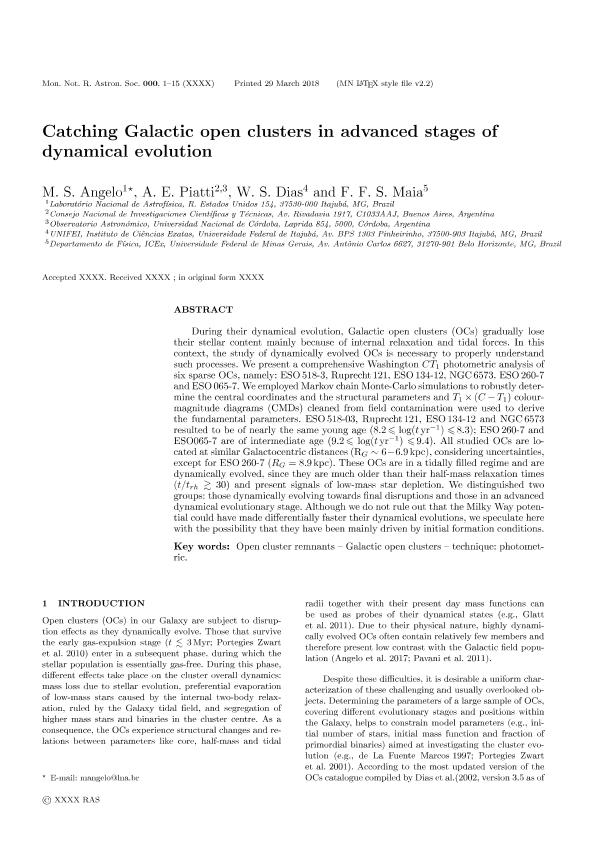Artículo
Catching Galactic open clusters in advanced stages of dynamical evolution
Fecha de publicación:
07/2018
Editorial:
Wiley Blackwell Publishing, Inc
Revista:
Monthly Notices of the Royal Astronomical Society
ISSN:
0035-8711
e-ISSN:
1365-2966
Idioma:
Inglés
Tipo de recurso:
Artículo publicado
Clasificación temática:
Resumen
During their dynamical evolution, Galactic open clusters (OCs) gradually lose their stellar content mainly because of internal relaxation and tidal forces. In this context, the study of dynamically evolved OCs is necessary to properly understand such processes. We present a comprehensive Washington CT1 photometric analysis of six sparse OCs, namely ESO 518-3, Ruprecht 121, ESO 134-12, NGC6573, ESO 260-7, and ESO 065-7. We employed Markov chainMonte Carlo simulations to robustly determine the central coordinates and the structural parameters and T1 × (C - T1) colour-magnitude diagrams cleaned from field contamination were used to derive the fundamental parameters. ESO 518-03, Ruprecht 121, ESO 134-12, and NGC6573 resulted to be of nearly the same young age [8.2≤log(t yr-1) ≤8.3]; ESO 260-7 and ESO065-7 are of intermediate age [9.2≤log(t yr-1) ≤9.4]. All studied OCs are located at similar Galactocentric distances (RG ~6-6.9 kpc), considering uncertainties, except for ESO 260-7 (RG = 8.9 kpc). These OCs are in a tidally filled regime and are dynamically evolved, since they are much older than their half-mass relaxation times (t/trh ≳ 30) and present signals of low-mass star depletion. We distinguished two groups: those dynamically evolving towards final disruptions and those in an advanced dynamical evolutionary stage. Although we do not rule out that theMilkyWay potential could have made differentially faster their dynamical evolutions, we speculate here with the possibility that they have been mainly driven by initial formation conditions.
Palabras clave:
OPEN CLUSTERS AND ASSOCIATIONS: GENERAL
,
TECHNIQUES: PHOTOMETRIC
Archivos asociados
Licencia
Identificadores
Colecciones
Articulos(CCT - CORDOBA)
Articulos de CTRO.CIENTIFICO TECNOL.CONICET - CORDOBA
Articulos de CTRO.CIENTIFICO TECNOL.CONICET - CORDOBA
Citación
Angelo, M.S.; Piatti, Andres Eduardo; Dias, W. S.; Maia, F. F. S.; Catching Galactic open clusters in advanced stages of dynamical evolution; Wiley Blackwell Publishing, Inc; Monthly Notices of the Royal Astronomical Society; 477; 3; 7-2018; 3600-3622
Compartir
Altmétricas




